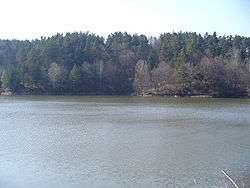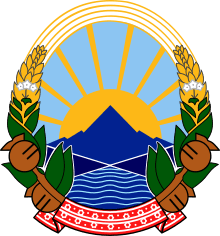Berovo
Berovo (Macedonian: Берово [ˈbɛrɔvɔ] (![]()
Berovo | |
|---|---|
 Flag 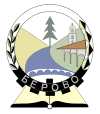 Seal | |
 Berovo Location within North Macedonia | |
| Coordinates: 41°42′36″N 22°51′0″E | |
| Country | |
| Region | |
| Municipality | |
| Government | |
| • Mayor | Zvonko Pekevski (SDSM) |
| Elevation | 986 m (3,235 ft) |
| Population (2002) | |
| • Total | 7,002 |
| Time zone | UTC+1 (CET) |
| • Summer (DST) | UTC+2 (CEST) |
| Postal code | 2330 |
| Area code(s) | +389 033 |
| Car plates | BE |
| Climate | Cfb |
| Website | www.berovo.gov.mk/ |
Demographics
According to the 2002 census, the town had a total of 7,002 inhabitants.[2] Ethnic groups in the village include:[2]
| Number | % | |
| TOTAL | 7,002 | 100 |
| Macedonians | 6,404 | 91.45 |
| Roma | 459 | 6.55 |
| others | 139 | 1.98 |
History
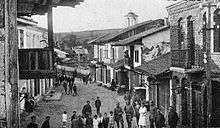
In the late 19th and early 20th century, Berovo was part of the Kosovo Vilayet of the Ottoman Empire. As a result of the Balkan Wars, the town was included in the area ceded in 1913 to the Kingdom of Serbia, which in 1918 joined the Kingdom of Serbs, Croats and Slovenes (renamed Kingdom of Yugoslavia in 1929). From 1929 to 1941, Berovo was part of the Vardar Banovina of the Kingdom of Yugoslavia. From 1941 to 1944, during the Axis occupation of Yugoslavia, Berovo, as most of Vardar Macedonia, was annexed by the Kingdom of Bulgaria.
Features
Sustained by the Bregalnica River, Berovo stands at 830–900 m (2,723–2,953 ft) above sea level and can be reached by car using a single asphalt road leading to the city. Berovo Lake and the forest of the Maleshevo Mountains are two popular sites for tourists and Berovo craftsmen are well known for their skill in traditional wood crafting. Berovo cheese is also a well-known commodity.
Culture
Monastery of the Holy Archangel Michael
The first monastery in Berovo was built between 1815 until it was consecrated in 1818. Enlightener Joachim Krcovski was among those present at the consecration. Historical data concerning the construction of the church and the monastery is inconclusive, but it is known that circumstances were very difficult.
In the early 19th century Berovo was a rural settlement with around two hundred houses and one small church that had fallen into decay. The inhabitants at the time decided to have a new church built at the site known as Mogila. The parish priest, Friar Peco, was assigned to obtain a building permit from the Turkish authorities in Radoviš. The Turkish governor Vali gave a building permit but made sure to set conditions for construction of the church as difficult as possible. The church was to be built low, below the road level and not to be seen, construction was to end in forty days, and Fr Peco was to give his youngest daughter, Sultana, to the harem. The people of the town prevailed and the church building was finished and covered with stone blocks, soot, and lime (so as not to be noticed) in 40 days. Seeing that the church had been completed, Vali immediately ordered the deaths of three church elders in front of the church, and since Sultana had fled to Kyustendil, Friar Peco was imprisoned for three years. When Sultana found out that Vali had been murdered by komitas, she promptly returned to Berovo.
Convent
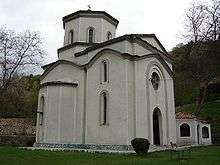
The first convent, located at the exit from Berovo leading to the dam and the lake, was built in 1940 in a 19th-century architectural opus, twenty years after the construction of the Monastery of the Holy Archangel Michael, and the first nuns were the daughter-in-law and the daughter of Friar Risto, a son-in-law of Friar Peco. They had their monastic tonsure (removal of the hair of the head) with a blessing from the Rila Monastery's abbott. Eugenia I was the first abbess of the convent, the second – Eugenia II, the third – Eugenia III, and the fourth abbess was Eulampia in 1958 by the first Archbishop of Ohrid, Dositheus. At its peak, in the first half of the twentieth century, the convent numbered up to sixty nuns, with a rich and developed economy, a theological seminary, a weaving mill, and the first single-phase hydro-power plant in this area was in the convent.
The three gates of the church face the town, the river and the pine forest. A large porch dominates the convent yard and in the dimness of its interior oil lamps lighten images of saints, painted in a characteristic style that is antonymic to Byzantine canons. Only one icon, that of Noah, painted by George Veljanov from Strumica in 1818. From 1897 to 1920 the painter Gavril Atanasov also worked in the convent. The icon of the Dormition of the Theotokos was painted by Gregory Pecanov from Strumica in 1878. The residential quarters are of a free-style construction. They attract with the warmth of the wood used, shaped in a 19th-century old-urban style.
Four sisters who came from the Veljusa monastery live together with the last nun of the previous lineage. The sisterhood of the convent is active in Byzantine style icon painting. The beginnings of the renewal of fresco painting in Macedonian monasteries was started by the sisterhood.
The Hesychastic (14th century Greek sect of Christianity) monastery typikon functions as a place of prayer, a holy hesychasterion. The upper floor of the church was recently turned into a small chapel dedicated to St. Gregory Palamas.
Local Politics
As of the municipal elections 2017 the new mayor of Berovo is Zvonko Pekevski.
Sports
Local football club FK Maleš play in the Macedonian Third League (Southeast Division).
People from Berovo
References
- "Berovo". www.exploringmacedonia.com. Archived from the original on February 16, 2019. Retrieved February 16, 2019.
- Macedonian Census (2002), Book 5 - Total population according to the Ethnic Affiliation, Mother Tongue and Religion, The State Statistical Office, Skopje, 2002, p. 68.
External links
| Wikimedia Commons has media related to Berovo. |
